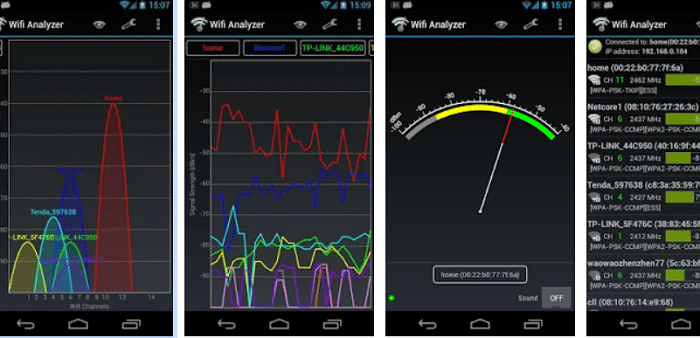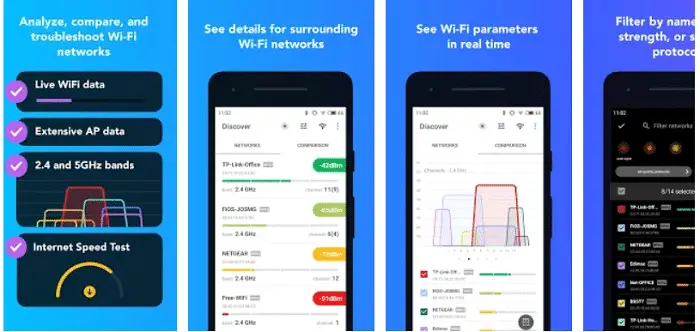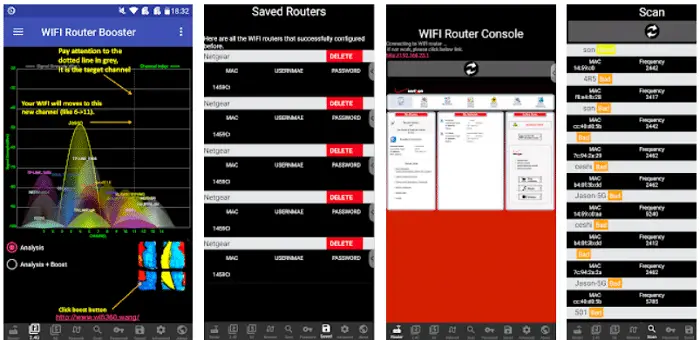Slow WiFi is on the path to becoming every person’s worst nightmare. That being said, the slow WiFi problem may not lie within your router or modem, and to fix the issue, several WiFi antenna booster for Android and iOS devices. Ever wondered how WiFi-boosting apps work? Well, here is how they do.
Some recommendations for Best WiFi Signal Boost Apps of 2023 are
- Glasswire
- NetSpot
- WiFi Analyzer
- WiFi Router Booster
- Open Signal
The former offers detailed information about your WiFi signal and helps you select the best network from a whole set of networks. You are also finding the optimum location for a router to get the best Signal. On the other hand, the latter find unnecessary files and documents on your device upon deletion, which can boost your overall RAM speed.
All in all, these apps don’t directly affect the speed of your WiFi. Instead, they work with the internal components of your device to improve the overall rate. Another way to boost your WiFi signal is to use an antenna for WiFi. Similarly, there are Wi-Fi hack apps for iPhones to increase your net speed. You said that earlier; here is a list of the top apps that work as a WiFi antenna booster for Android.
Table of Contents
5 Best WiFi Signal Boost Apps of 2023
Today, learn about the top apps to boost your WiFi signal with our quick guide!
Glasswire
By far, the most popular WiFi antenna booster for Android is Glasswire. It has received brilliant reviews on the Google Play Store, with over a million downloads. The app supervises your mobile phone’s data usage, WiFi Network activity, and limits. It showcases a graph of all the apps on your phone in the order in which they consume your data and shows you a history of a single app’s data usage.
 Likewise, you can use Glasswire’s Speed Meter to test your real-time data usage. Additionally, it helps safeguard your privacy by instantly catching up on any suspicious activity within an app and producing multiple firewall profiles to block certain apps from joining the network. Hence, it is an all-in-one free package to help optimize your router for a better WiFi speed.
Likewise, you can use Glasswire’s Speed Meter to test your real-time data usage. Additionally, it helps safeguard your privacy by instantly catching up on any suspicious activity within an app and producing multiple firewall profiles to block certain apps from joining the network. Hence, it is an all-in-one free package to help optimize your router for a better WiFi speed.
Visit: Glasswire
See also: Does Dual-Band Router Switch Automatically?
NetSpot
NetSpot is an excellent WiFi antenna booster for Android that works considerably well. The application is free for installation and has gotten decent reviews on the Google Play Store. With NetSpot, you can scan your surrounding wireless networks, quickly compare your WiFi with others based on the signal strength and WiFi Channel, test your internet’s speed and collect and visualize live WiFi data.
Additionally, the application helps you set up your router as well. It is also ideal for monitoring any network issues and detecting signal leaks. It is a perfect app if you’re looking for a free WiFi antenna booster for Android.
Visit: Netspot
WiFi Analyzer
Another great WiFi antenna booster for Android on our list is WiFi Analyzer. Along with great reviews, it is also entirely free for download; however, the application does run ads. With WiFi Analyzer, you can modify and analyze your WiFi as required. It proposes the most suitable channels with the most minor traffic and an ideal place for the network.
 The application also provides valuable information on your router’s configuration to help improve overall network speed and stability. It provides real-time data and distance calculations, analyzing channels for close by APs. It gives you a view of hidden WiFi networks and a history of your Signal’s strength. Overall, it is a great app that does exactly what it says it will.
The application also provides valuable information on your router’s configuration to help improve overall network speed and stability. It provides real-time data and distance calculations, analyzing channels for close by APs. It gives you a view of hidden WiFi networks and a history of your Signal’s strength. Overall, it is a great app that does exactly what it says it will.
Visit: WiFi Analyzer
WiFi Router Booster
The following brilliant WiFi antenna booster for Android on our list is the WiFi Router booster. This app recommends to you the best course of action when it comes to the configuration of your router. The app will boost your WiFi routers by analyzing and figuring out the best WiFi channels. This gives you the best WiFi performance.
It will aid you by auto-configuring your router based on various parameters: channel, power, priority, and much more. The application has received mixed reviews on the app store. However, it has worked out considerably well for several of its users.
Visit: WiFi Router booster
Open Signal
With over 10 million downloads and brilliant reviews on the Google Play Store, we are ending on a high note by recommending Open Signal. Open Signal is an application that does it all and is undoubtedly a brilliant WiFi antenna booster for Android. With Open Signal, you can test your network’s speed and find the ultimate network providers within your vicinity.
You can also compare your respective network by measuring the connection quality on any Google map with an extensive database of speed tests and signal results. You can also test the latency response and get a signal alert when you have no data or call connectivity. It also accounts for the time spent on 3G and 4G/LTE connectivity and has no data to show the network accessibility in the areas you visit the most.
Overall, the app is ideal for truly understanding your WiFi’s performance and optimizing it to its fullest potential.
Visit: OpenSignal
FAQs
How can I boost my WiFi signal on my Android phone?
1. Wise Router Positioning: Set up your router within a clear, accessible area away from any obstacles. 2. Use 5GHz Band: If available, switch to the 5GHz band for less interference. 3. Extend Range: Consider WiFi range extenders. 4. Update Firmware: Keep router firmware up to date. 5. Limit Interference: Reduce intrusion from other gadgets 6. Upgrade Router: If needed, upgrade to a better router.
Do WiFi antenna boosters work?
WiFi antenna boosters can improve signal strength, but their effectiveness varies. They work best in specific scenarios, like extending coverage in large spaces. However, for typical home use, repositioning the router or using a WiFi extender is often more practical and effective than antenna boosters.
Can you boost a mobile WiFi signal?
Boosting a mobile WiFi signal is possible using several methods: 1. Employ a Signal Booster: This may assist in enhancing signal strength. 2. Change Location: Move to an area with better signal reception. 3. Upgrade Plan: Choose a higher-tier data plan for better connectivity. 4. WiFi Calling: Enable WiFi calling on your device for improved voice calls over WiFi. 5. Use a WiFi Extender: Extend WiFi coverage with a range extender.
How can I increase my WiFi range with antenna?
To increase WiFi range with an antenna: 1. Replace the Router's Antenna:Use a high-gain or directional antenna. 2. Position the Antenna: For optimum coverage, orient it in the preferred direction. 3. Use a WiFi Range Extender; Amplify and extend your signal. 4. Upgrade Router: Consider a router with better antennas or mesh WiFi systems for broader coverage.
Conclusion
So this was our ultimate list of WiFi antenna booster for Android tablets, phones, etc.
With the increasing need for a robust WiFi and data connection for daily needs, these apps will surely enhance your overall user experience.



